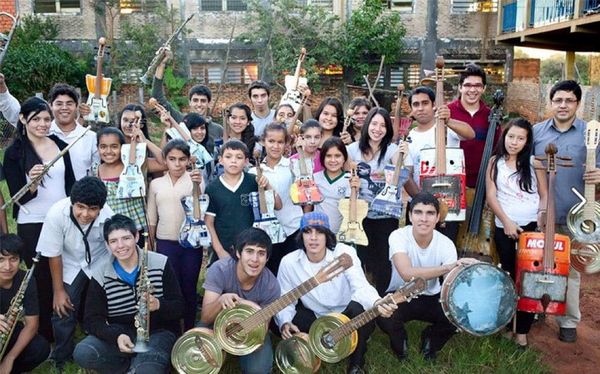Eye For Film >> Movies >> Landfill Harmonic (2015) Film Review
Landfill Harmonic
Reviewed by: Anne-Katrin Titze

When Megadeth's Dave Mustaine, David Ellefson, Shawn Drover and Chris Broderick meet the enthusiastic emerging musicians from Cateura, Paraguay and perform with them their Symphony Of Destruction at an arena concert in Denver, Colorado in Brad Allgood and Graham Townsley's immersive Landfill Harmonic, co-directed by Juliana Peñaranda-Loftus, we see the mighty impact of the universal language of music in full flower.
This affecting film focuses on Favio Chávez, the ardent director and founder of the Recycled Orchestra of Cateura, who came to the region in 2006, as an environmental technician, to oversee the start of a recycling program at the landfill there. This is a large dumping ground for the rubbish from Asunción, capital city of Paraguay. 1,500 tons of debris arrive every day at the location that has 2,500 families living and working nearby.

The challenge for him to improve the conditions appears to be insurmountable until the lover of music has a chance meeting with a former carpenter who is working the landfill. The warm-hearted and very imaginative Colá Gomez and Chávez come up with a plan to make instruments out of the garbage that can be gleaned from the mounting trash.
Palettes, wooden spoons, forks, metal canisters, discarded x-rays, spigots and even the pink, size 12 heel from a shoe become transformed magically into parts for violins, cellos, guitars, a drum set, and more, through the artistic vision of Gomez. Now with the recycled items, there is newly found hope for Favio Chávez to be able to teach the young citizens of Cateura how to play.
Young potential musicians flock to the pop-up school he starts when he puts out notices of music lessons for free. We meet 13-year-old Ada Ríos, her sister Noelia, Tania, María, Estéban, Natalia, and many more as they discover the commitment and work it takes to learn their instruments. Ada tells us how her grandmother signed her up for the lessons without telling her. A common goal of forming an orchestra changes the tenor of the community as friendships develop and the real opportunity for change is placed before them.
Chávez, with great kindness as well as authority, reminds his students to be patient and not become discouraged if they make a mistake rehearsing Beethoven's Ode To Joy. Tania learning to play her violin states that "without music, my life would be meaningless." María says about her violin: "I treat it like a jewel" and she does. The creative spirit displayed by the young, adventurous musicians in the Landfill Harmonic is a joy to behold.
The support of the family members involved in the children's lives is all important, not only for overcoming the odds of getting the orchestra off the ground, but being able to let them fly with their dreams of performing in public.
As a teenager, Ada and Noelia's father Jorge, a landfill worker (ranchero), became a big fan of Phil Collins after finding a cassette tape in the pile. He also professes being influenced by Black Sabbath and Led Zeppelin, as his collection of found cassette tapes increases. A slim paperback on musicians from all over the world that includes Mozart, Bach and Beethoven with Jimi Hendrix and the Sex Pistols thrown in, expanded his awareness. He comments proudly that one of his most important contributions to his daughters is sharing his love of music with them.
As we see the polluted creek that runs through their neighborhood, Mirian Cardozo, Ada and Noelia's grandmother, who is quite aware of the need for the protection of nature through the use of erosion control with her plantings, talks (in 2012) about the nearly dried up arroyo where decades ago she used to wash clothes and where the children could bathe. "I'm convinced that the environment and deterioration of our surroundings determines our quality of life", she says.
As the Recycled Orchestra prepares for their first international performance, we see them buying matching pale blue shirts in Asunción to wear as a statement of solidarity, rather than a uniform. The invitation came from the +20 World Summit in Rio. The pure happiness on their faces when they have the time to romp in the ocean following the show is in stark contrast to the end of term beach scene in Deniz Gamze Ergüven's Mustang.
A posting on the internet of the Rio performance creates a sensation and ends up turning into a media frenzy with outlets all over the world suddenly picking up on their story. Ada speaks about painting the name Megadeth, with some of the members, on the Paraguayan flag, and posting a photo on her Facebook with them holding their recycled instruments. She also shares her post on David Ellefson's page.
The Megadeth bassist arrives in Cateura to show his support for their endeavour and cheerfully takes photos with the delighted members of the orchestra. When the invitation to perform in a show with Megadeth in the United States comes, Favio Chávez says, "Opportunities like this are like a train that only passes once in life. You have to take the chance even though you never feel totally prepared."
In Denver, Megadeth's road manager Jim Carroccio takes them through the ropes when they arrive at the arena for the soundcheck. We see the members soaking it all in with awe as they work on orienting themselves to the magnitude of what is going to happen that night. The energy level from the Recycled Orchestra ignites on the stage as they kick in with their perfectly executed contribution to Symphony of Destruction, conducted by Favio Chávez.
The film takes us on a journey through the lives of those who through perseverance never give up on each other and continue to look for ways to improve their situation even under the most extreme circumstances. In 2012, Mirian Cardozo also talked about past floods, and said "thank God it doesn't flood anymore". Until it does.
The nightmare of the devastating flooding of the Cateura region in June 2014 turns into the third act of the film and the rebuilding for the families who live there is still going on today. As Favio Chávez told me in New York: "The secret is to start looking at garbage in another way. It's to give things a second opportunity. And from there you just have to let your imagination fly. If we see things in a different way, garbage in a different way, we would throw away less things. We would have less garbage to begin with, less contamination, less consumerism. That's the message we want to share with the instruments."
Landfill Harmonic is much more than a feel-good film about young people seeing some of their dreams come true.
Reviewed on: 14 Sep 2016













